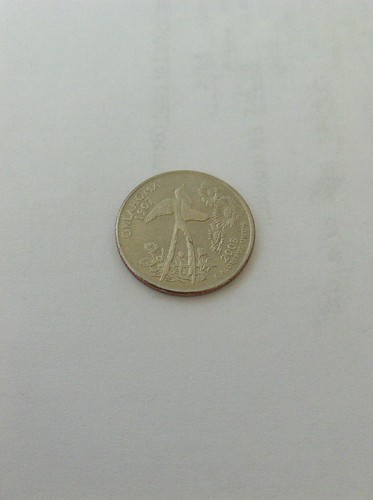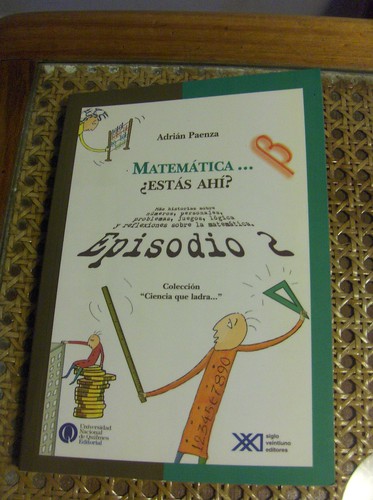************* Before 2000 ********** After 2000
Small coins .....................15.................................172
Large coins ....................138................................6
Above is the updated (and final - this investigation is now closed) version of the table presented in an earlier post (sorry for the ASCII graphics, Jerome!)
It is clear from the table that the hypothesis suggested by the earlier table, which had zeros on the left-right diagonal, did not pan out entirely. Some large coins were manufactured after 2000; all were one-peso coins, with a manufacture date of 2006 or later. In seven weeks, inspection of my own change, and that of classmates coerced into participation in my little investigation, found not a single 25- or 50-centavo piece manufactured after the year 1997. Similarly, older 5- and 10-centavo pieces are a distinct rarity.
Make of it what you will. When I get home, I will never take my penny jar for granted again.
Speaking of coins, if any readers of this blog could please explain to me exactly what is depicted on the Oklahoma state quarter, I'd greatly appreciate it. Is it a bird? Is it a man? Is it .. WHAT the hell is it?

Still on the topic of coins, here's a little estimation puzzle, taken from the following delightful book*:

Suppose you are on the pavement outside a 100-story building. The challenge is to erect a column of coins (they could be Argentine pesos, but as we know you'd never scrape together enough, so let's say they are U.S. quarters, which are roughly the same size). At your disposal are as many carts of quarters as you need; each cart contains a cubic meter of coins. How many carts should you ask for?
First take a guess, just based on your intuition. Then check your intuition, based on some reasonable approximations. A white-fonted hint is given below, to see it, just drag your mouse over it, while holding the left button down. Solution available on my return to the U.S. But give it a shot - it's kind of fun to figure it out.
Hint: The width of the coins is not a relevant consideration in this problem
*: Adrián Paenza is a former sports journalist, who went back to university to get his Ph.D. in math, and is now professor of mathematics at the University of Buenos Aires. Invited to write a weekly math column for the newspaper**, the first collection of those columns, "Mathematics: are you there?", became a runaway bestseller, as did the two followup volumes. (For instance, Nestor, the doorman in the school building, was a great fan, as was Ciro).
I was amused to note that volume 2 (pictured above) contains the classic "how do you measure out 4 liters, if all you have is a 3-liter and a 5-liter jug?" problem. Amused because the scarcity of coins virtually guarantees that any Buenos Aires resident will be adept in the kind of instinctive mental calculation needed to solve that particular problem. As an example, if I buy something for 9 pesos, and offer the merchant a 20-peso note, it's a virtual certainty that he will ask me if I have a single peso. If I acquiesce, he can then give me a 10-peso and 2-peso note in change, while upping his stock of peso coins by one; if I don't he is forced to give me at least one coin as part of my change, which might just ruin his entire day.
**: Yeah. It's a misplaced modifier. So sue me. You know exactly what the sentence means.







1 comment:
Since you like numbers, about.com reports that despite the vote below, the federal coin commission chose a simpler design for the OK coin, the state bird, a scissortail flycatcher, and state flower, Indian blanket. But here are stats from initial vote. And what's a calumet, you might ask? --Pb
After the conclusion of the initial online voting, Governor Brad Henry's office announced the 5 winners. The 5 choices with the highest vote totals were submitted to various national committees and organizations.
The winners were:
* With 43,720 votes, the design that featured the state outline in the upper left, an oil derrick to the right, a calumet in the middle and the Pioneer Woman statue on the lower left received the largest support.
* With 42,118 votes, the design that prominently features the scissortail flycatcher finished a narrow 2nd.
* With 39,659 votes, the design featuring the Pioneer Woman statue in the middle with an oil derrick to her left and a windmill to her right came in 3rd.
* With 34,819 votes, the design featuring the Pioneer Woman statue and oil derrick upon a state outline background came in 4th.
* And with 29,375 votes, the design with the state outline background behind a calumet and the Pioneer Woman statue rounded out the top 5.
Post a Comment